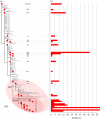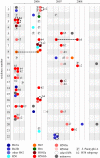Combined high-resolution genotyping and geospatial analysis reveals modes of endemic urban typhoid fever transmission
- PMID: 22645647
- PMCID: PMC3352080
- DOI: 10.1098/rsob.110008
Combined high-resolution genotyping and geospatial analysis reveals modes of endemic urban typhoid fever transmission
Abstract
Typhoid is a systemic infection caused by Salmonella Typhi and Salmonella Paratyphi A, human-restricted bacteria that are transmitted faeco-orally. Salmonella Typhi and S. Paratyphi A are clonal, and their limited genetic diversity has precluded the identification of long-term transmission networks in areas with a high disease burden. To improve our understanding of typhoid transmission we have taken a novel approach, performing a longitudinal spatial case-control study for typhoid in Nepal, combining single-nucleotide polymorphism genotyping and case localization via global positioning. We show extensive clustering of typhoid occurring independent of population size and density. For the first time, we demonstrate an extensive range of genotypes existing within typhoid clusters, and even within individual households, including some resulting from clonal expansion. Furthermore, although the data provide evidence for direct human-to-human transmission, we demonstrate an overwhelming contribution of indirect transmission, potentially via contaminated water. Consistent with this, we detected S. Typhi and S. Paratyphi A in water supplies and found that typhoid was spatially associated with public water sources and low elevation. These findings have implications for typhoid-control strategies, and our innovative approach may be applied to other diseases caused by other monophyletic or emerging pathogens.
Keywords: Salmonella, typhoid, Paratyphoid, genotyping, transmission, geospatial.
Figures





References
-
- Basnyat B. 2005. Typhoid and paratyphoid fever. Lancet 366, 1603.10.1016/S0140-6736(05)67652-0 (doi:10.1016/S0140-6736(05)67652-0) - DOI - DOI - PubMed
-
- Parry CM, Hien TT, Dougan G, White NJ, Farrar JJ. 2002. Typhoid fever. N. Engl. J. Med. 347, 1770–178210.1056/NEJMra020201 (doi:10.1056/NEJMra020201) - DOI - DOI - PubMed
-
- Basnyat B, Maskey AP, Zimmerman MD, Murdoch DR. 2005. Enteric (typhoid) fever in travelers. Clin. Infect. Dis. 41, 1467–147210.1086/497136 (doi:10.1086/497136) - DOI - DOI - PubMed
-
- Ledingham J. C. G. 1912. The carrier problem in infectious diseases. London, UK: Edward Arnold
Publication types
MeSH terms
Grants and funding
LinkOut - more resources
Full Text Sources

